Icelandic domestic football doesn’t tend to attract many fans from outside of the country, with it not being widely available to watch in the wider world, and yet both the men’s and women’s leagues are well worth keeping an eye on due to how competitive they can be. This is especially true of the women’s top flight, the Besta deild kvenna, with the 2023 season seeing plenty of teams challenging for a place in next season’s Champions League qualifiers, including Valur Women and Breiðablik Women, who currently occupy the top two places, as well as Hafnarfjörður-based FH Women and Akureyri-situated Þór/KA.
One team who should be in the mix and yet are currently not are Stjarnan Women, which is a big surprise given that they finished second in the 2022 campaign and are generally seen as one of the main challengers each year for a Champions League position. However, as this tactical analysis will show, they have not had a season to remember so far, with them being continually let down by disappointing results and poor performances, both of which have left them sitting sixth in the league and eight points off second-placed Valur with just eight matches left to play.
Nevertheless, whilst that does make for grim reading, all is not lost yet, and this analysis will highlight not just where they have been making mistakes but also why they can be optimistic of a comeback, with there being several aspects of their games that have gone well and that can give them much-needed confidence for the battle ahead.
Attack
Focusing firstly on Stjarnan Women’s attacking play, what is important to mention is that there aren’t many major things going wrong, with it only coming down to details here and there that aren’t being executed correctly and which can be fixed on the training ground.
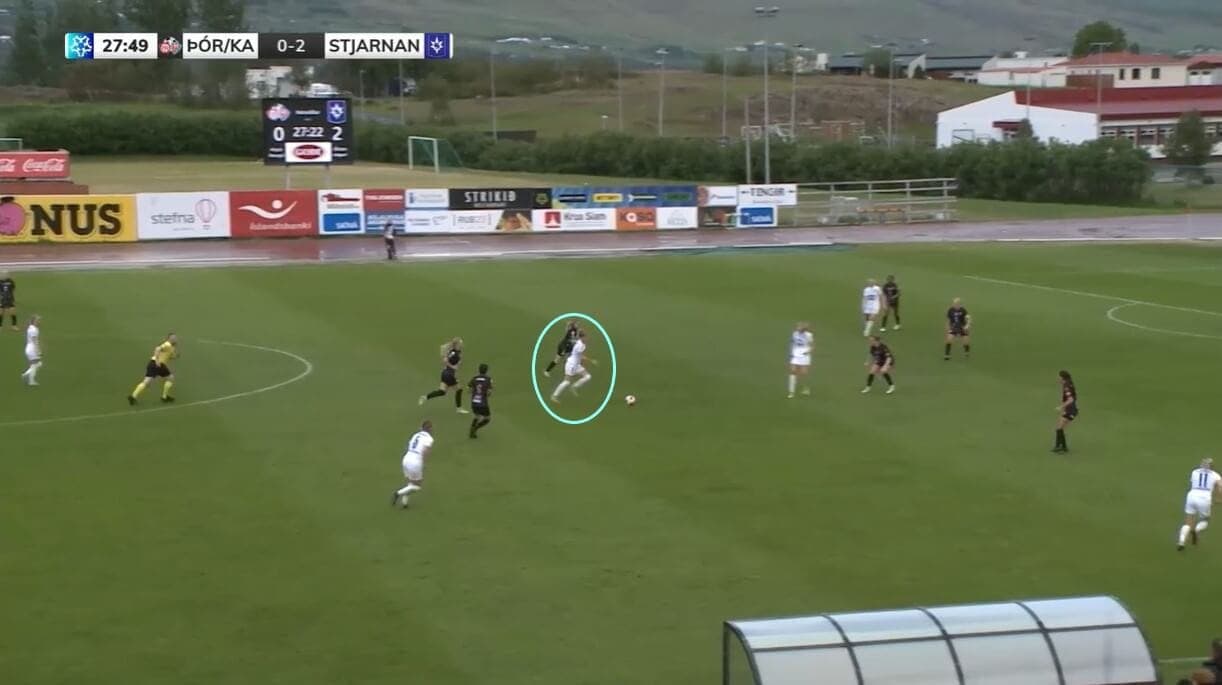
One of the things that has stood out is their tendency to lack patience when building phases of play, with individual players seeking to take things on themselves rather than working with the rest of the team to really test their opponents’ resolve. In this case, Úlfa Úlfarsdóttir has moved the ball into a promising position and has options ahead of her, but decides instead to shoot at goal from this range and sees her effort travel well wide of Þór/KA’s goal.
Úlfarsdóttir is a repeat offender when it comes to these situations, with her often trying her luck from far out and making it easy for opponents to gain possession, and she does deserve some credit for being brave enough to take responsibility for her team’s attacks. However, when looking at why Stjarnan are failing to pick up points against teams that they will feel they should be, this has to be taken into account, and better decision-making is required at times.
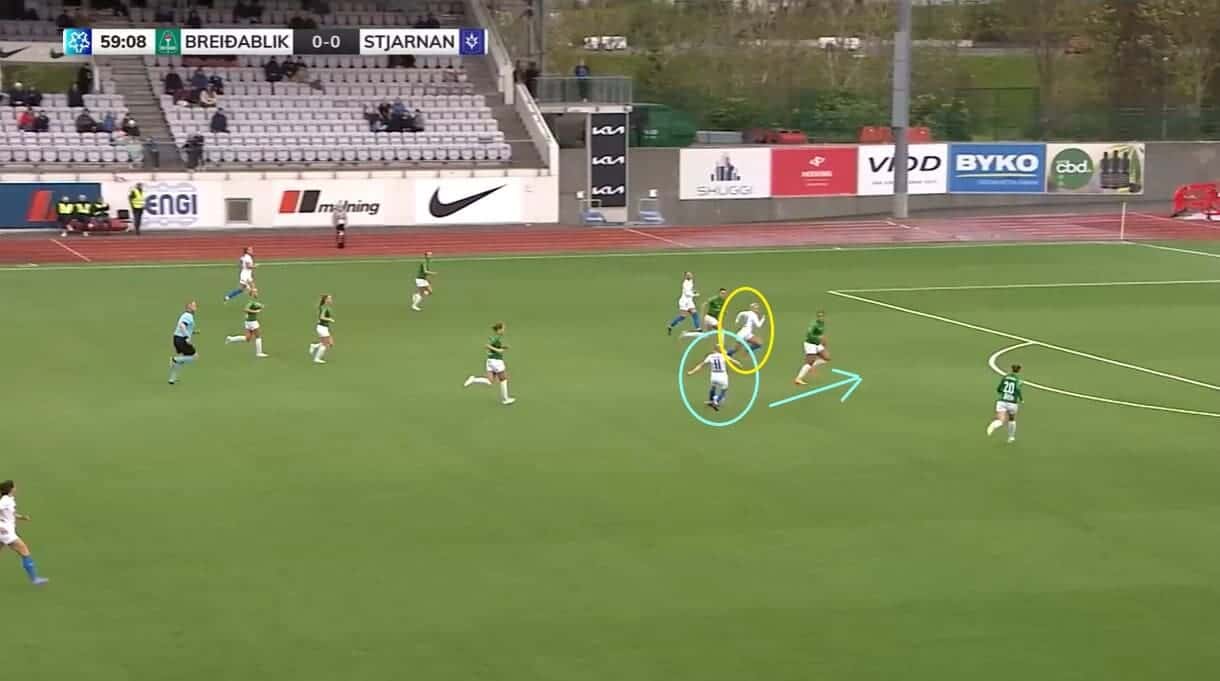
One of the reasons that Úlfarsdóttir does look to shoot rather than pass is because Stjarnan don’t have the best record when it comes to executing the final pass or cross inside the final third, meaning that, whilst their build-up play is generally very positive, with them registering a 76.7% passing accuracy so far this year, they are often unable to take their opportunities. In this case, the ball has arrived at the feet of New Zealand midfielder Betsy Hassett and she has the chance to play it through for Jasmín Erla Ingadóttir to run onto, and it looks like a fairly simple pass to make given that there is a gap in the Breiðablik defensive line for her to exploit.
However, her pass lacks both pace and accuracy and is easily intercepted by Breiðablik’s former Orlando Pride captain Toni Pressley as a result. Therefore, again, when they get into these areas, they don’t allow themselves to make the most of their opportunities, and this is something that will need addressing if they are to fight their way into the top two before the season reaches its conclusion.
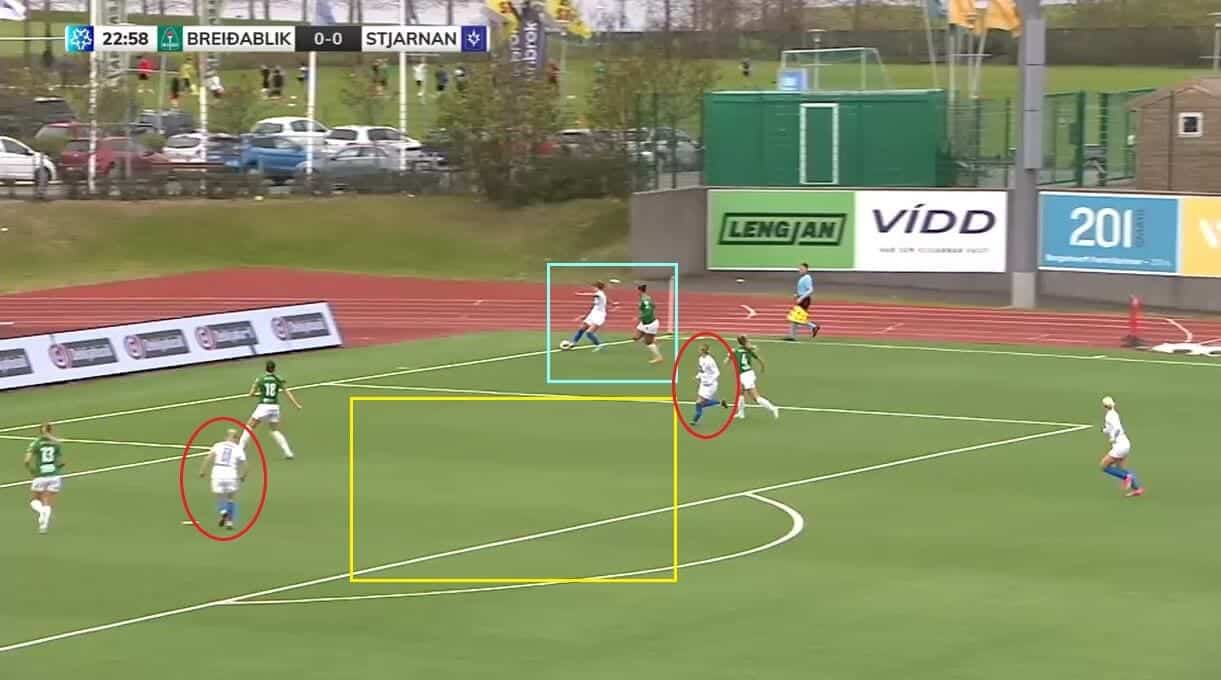
It is not only in the middle where this lack of quality is an issue because crosses have proven to be just as problematic for Stjarnan as the season has gone on, with them again working hard to get the ball into dangerous spaces but then not capitalising on that to put it into the back of the net. In this case, Úlfarsdóttir has defeated Pressley in a 1-v-1 duel on the far side of the field and has made it to the byline, where she is looking for an option inside the pitch to transfer the ball to.
As the yellow square indicates, there is a perfect target area towards the edge of the Breiðablik goal area that she could aim for, with there being no defenders in that area and the possibility of both Hassett and Gunnhildur Jónsdóttir, also formerly of Orlando, controlling it and shooting at goal.
However, Úlfarsdóttir doesn’t connect with the ball correctly and ends up hitting it too straight, meaning that it travels behind the Breiðablik players and into the hands of goalkeeper Telma Ívarsdóttir.
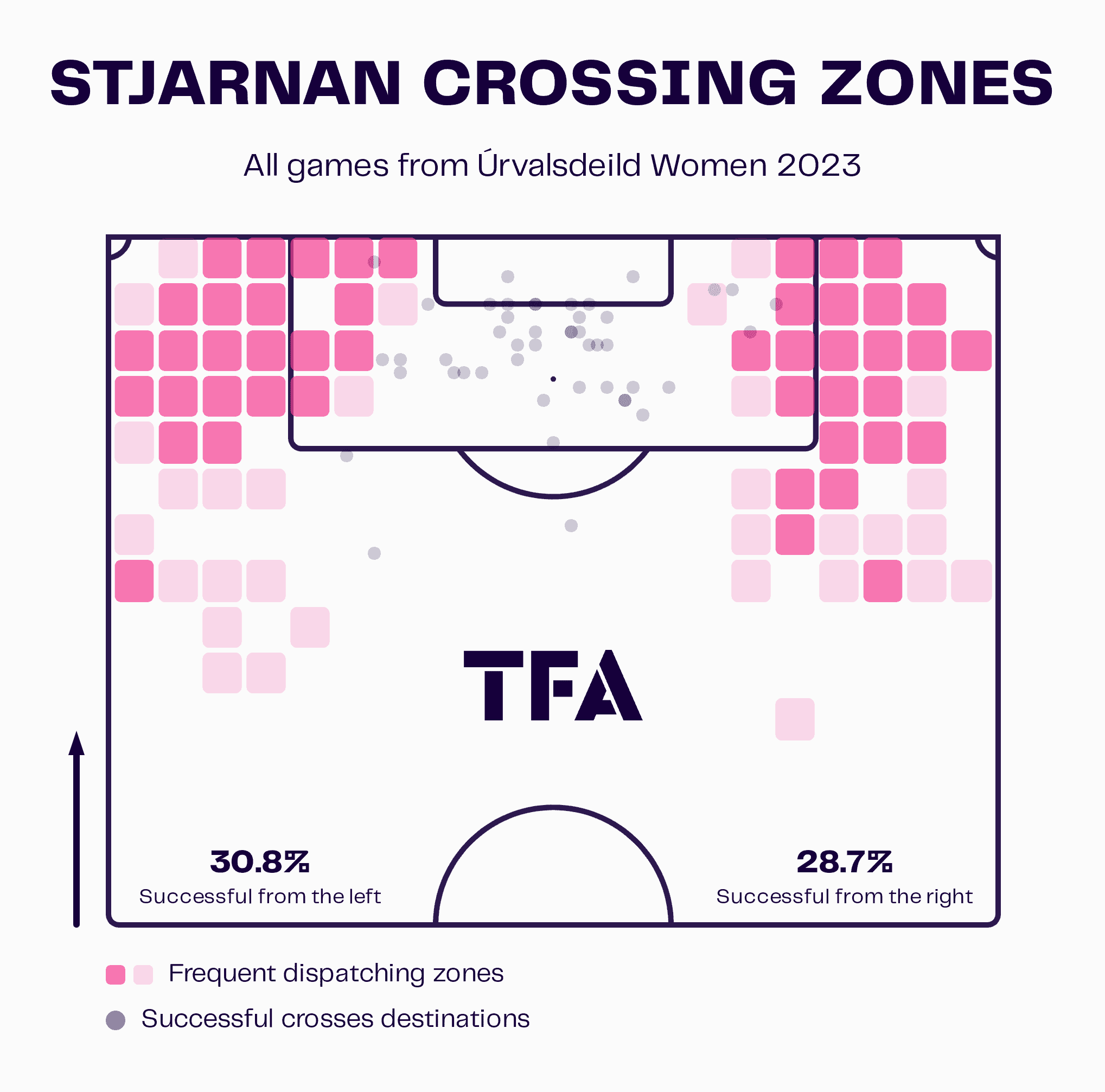
Getting tight to the goal line is not uncommon in Icelandic tactics, with plenty of teams in the top flight, including Breiðablik and Valur, integrating it into their own game plans. However, it only works if the delivery is executed correctly, and, whilst other teams don’t often have trouble with them, this graphic indicates how it has often been Stjarnan’s bane, with them only having a 30.8% accuracy from the left and a 28.7% accuracy from the right.
Therefore, if they want to persevere with this style of play, then they will need to increase the accuracy of their crosses, because, again, their build-up play is generally good and they do win a number of duels on the wings (34.8% to be precise), but it often comes to nothing once the ball is sent towards the middle.
Defence
Whilst the attacking issues are tiny details that can be remedied, there are bigger concerns in defence, with plenty of individual and team errors making Stjarnan Women a very easy team to break down at times and contributing in no small part to their so-far underwhelming campaign.
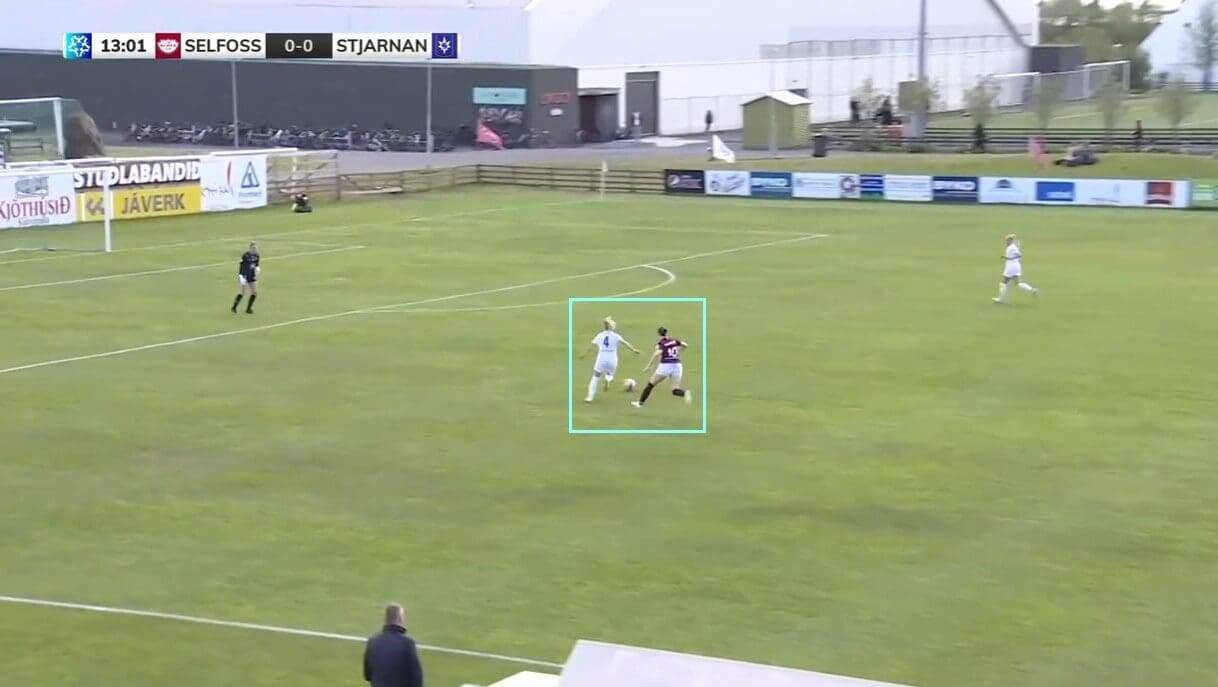
Individual mistakes are a big part of it, with there being plenty of moments where it looks like the team has control and they have then allowed their opponents to get the better of them, and it is no doubt frustrating for those watching on the sidelines and in the stands to witness. In this case, during the game against bottom side Selfoss Women, Stjarnan have looked to tidy up an overhit pass and get the ball moving back up the field again, and it appeared as if centre-back Eyrún Embla Hjartardóttir would be able to do just that.
However, with her under pressure from Selfoss’ Barbára Sól Gísladóttir, Hjartardóttir gets caught in two minds and ends up hesitating with the ball, which is all the invitation that Gísladóttir needs and she swiftly dislodges the ball and runs through to score. It was a really poor goal for Stjarnan to give away and was one that cost them dearly as things turned out, with the final score seeing them lose 2-1, and the fact that they have conceded an average of 1.1 goals per game and have seen 41.7% of shots against them head on target is not surprising when looking at how easy they make it at times for opponents to break them down.
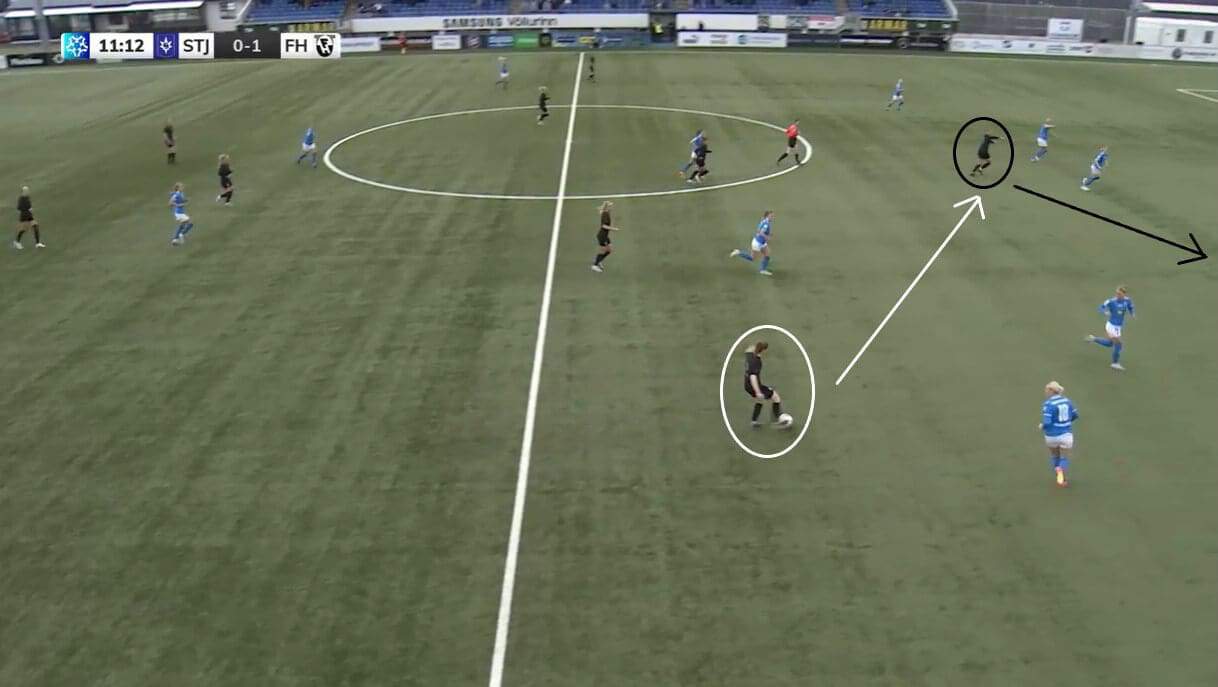
However, it is not just individual mistakes that need to be highlighted in this scout report, because there have been plenty of occasions when the whole team has lacked coordination and organisation, and that has also contributed to their poor form. The match against FH was a prime example of that, with them leaving so much space open between their lines and simply allowing their opponents to move the ball into the areas behind their defensive line, and it was a game where their weaknesses were really laid bare for all to see.
In this particular move, it took the visitors just three passes to transfer the ball from right-back Birna Kristín Björnsdóttir, who regained it inside her own half, to American forward Mackenzie George, who had made a run behind the home side’s back line, with Esther Rós Arnarsdóttir providing the link between the two, and it gets worse for Stjarnan when considering that George’s next pass set up Arnarsdóttir to fire the ball into the back of the net.
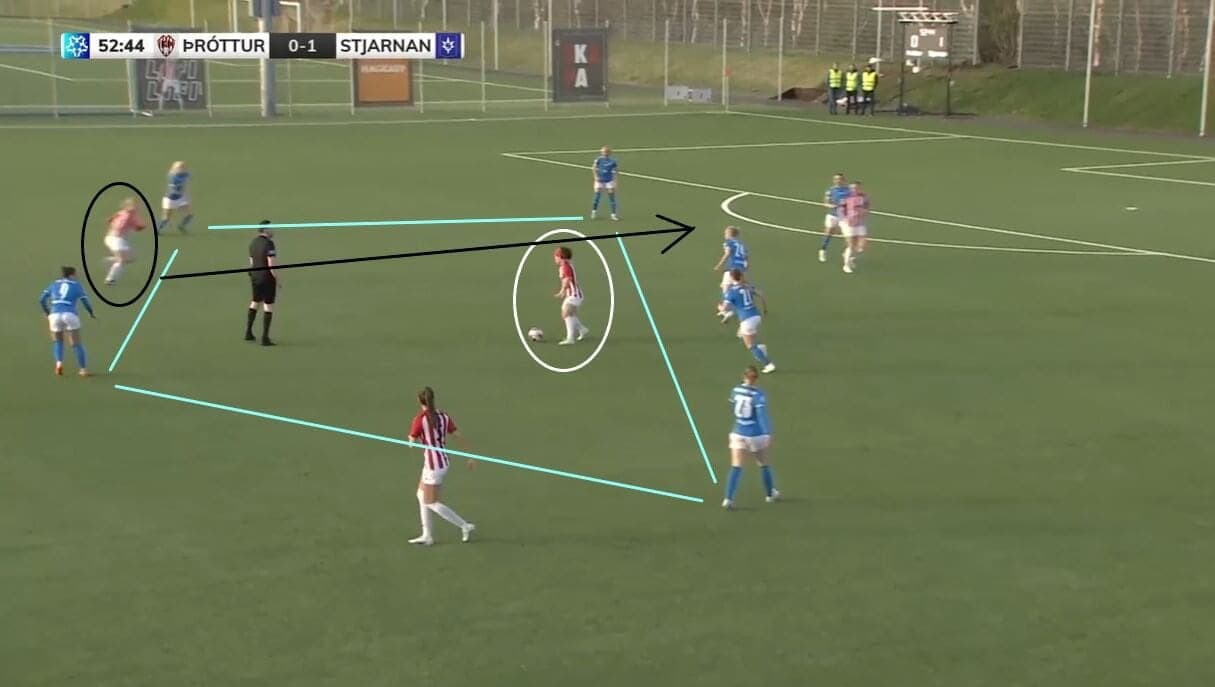
What is clear about moments like that is that there is a general lack of communication in Stjarnan’s ranks, and it is absolutely vital for that to be present if they are to mount a serious top-two challenge. However, as the game against Þróttur Reykjavík Women showed, it is a common missing feature in their play, and there is little doubt that it has contributed to them being so easy to play against when out of possession.
In this case, they once again gave the ball away too easily through Gyða Kristín Gunnarsdóttir and allowed Jelena Tinna Kujundzic to play the ball into the feet of Katie Cousins, but then didn’t react quickly enough to close it down. Cousins has shown during her time in the Icelandic capital that she is a midfielder who carries a significant influence on the field and a lot of Þróttur’s good moments come through her, so the fact that she had so much time and space here was always going to work against Stjarnan.
In the end, her pass into the path of the oncoming Katla Tryggvadóttir led to a shot on goal which was only stopped by former Canada goalkeeper Erin McLeod coming out well to meet the ball, but this is definitely something that Stjarnan need to look at as they try to recover from a poor first half of the campaign.
Reasons to be positive
However, as mentioned at the beginning of the scout report, there are positives to Stjarnan Women’s play as well as negatives, and that is what Kristján Gudmundsson’s side need to hold onto as they plot their way back into the top two reckoning and try to seal another season of Champions League football.
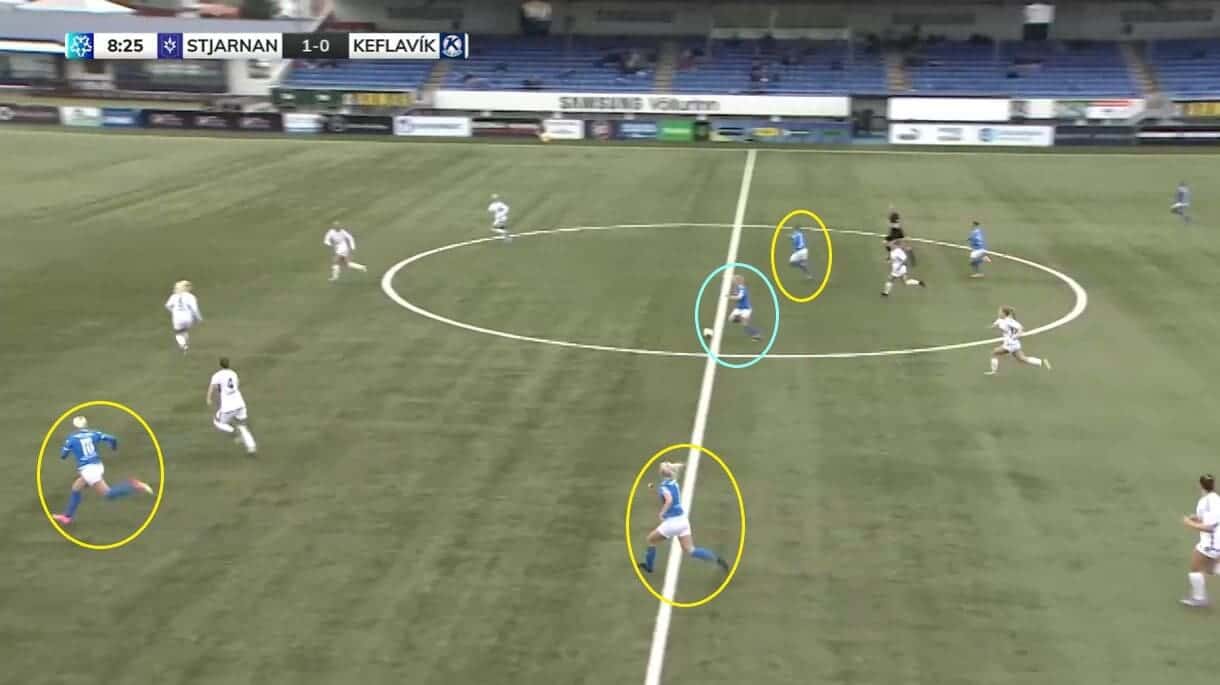
What is abundantly clear about Stjarnan’s tactics is that they rely on positional rotations a lot of the time, with those in and around the final third often switching roles and either dropping deep or pushing forward or moving between channels, and that is perhaps one explanation for the aforementioned lapses in communication.
When those rotations allow every player to get into the spaces where they are at their most comfortable though, Stjarnan look like a team capable of anything, and Keflavik Women found that out continuously in their trip to Stjörnuvöllur, with them unable to contain the waves of attacks that the home side were able to construct. In this case, with Hassett in the middle, Ingadóttir ahead of her and Jónsdóttir and Aníta Ýr Þorvaldsdóttir either side, there are clear and distinct options for Stjarnan to utilise, and they appeared balanced in this setup and more at ease with what they were looking to do.
As a result, this particular counterattack saw Hassett, who thrives in this progressive role for her country, moving the ball towards the far side of the field for Jónsdóttir to run onto, and it was the right choice on this occasion as it opened up the space on that side of the pitch for Stjarnan to exploit. Therefore, whilst there have been plenty of instances when Stjarnan have not looked settled during transitions, this was one where they did, and it made a huge difference and showed why they have averaged 1.2 goals per game and have converted 35% of their counterattacks into a shot on goal.
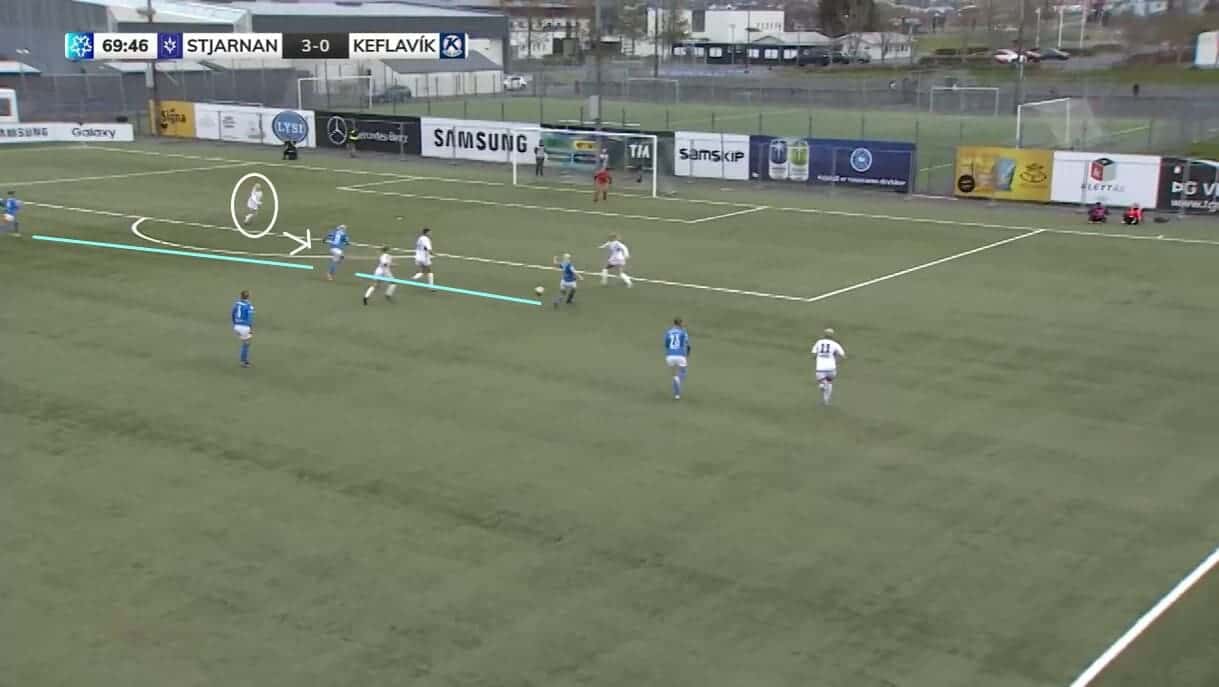
Attacking with numbers is another thing that Stjarnan need to keep doing as much of as possible, because it again gives them balance and allows them to stretch out and manipulate opposing defensive lines. Here, they have regained possession in an advanced position and have immediately set up with a front three structure, and that makes it difficult for Keflavik to close the ball down immediately and so gives Stjarnan additional time on the ball as they pick their passes. However, because Keflavik recognise the need to end the threat, they still come towards the ball and that leaves Andrea Mist Pálsdóttir free on the far side of the area to shoot at goal.
On this occasion, the opportunity didn’t lead to anything as Keflavik’s Finnish stopper Vera Varis got out well to make a save, but what is important here is to look at how easy it was for Stjarnan to cause confusion among their opponents’ ranks, and the fact that Madison Wolfbauer and Mikaela Nótt Pétursdóttir ended up colliding with each other as they tried to get to the ball shows just how effective this can be as a tactic when it is executed well.
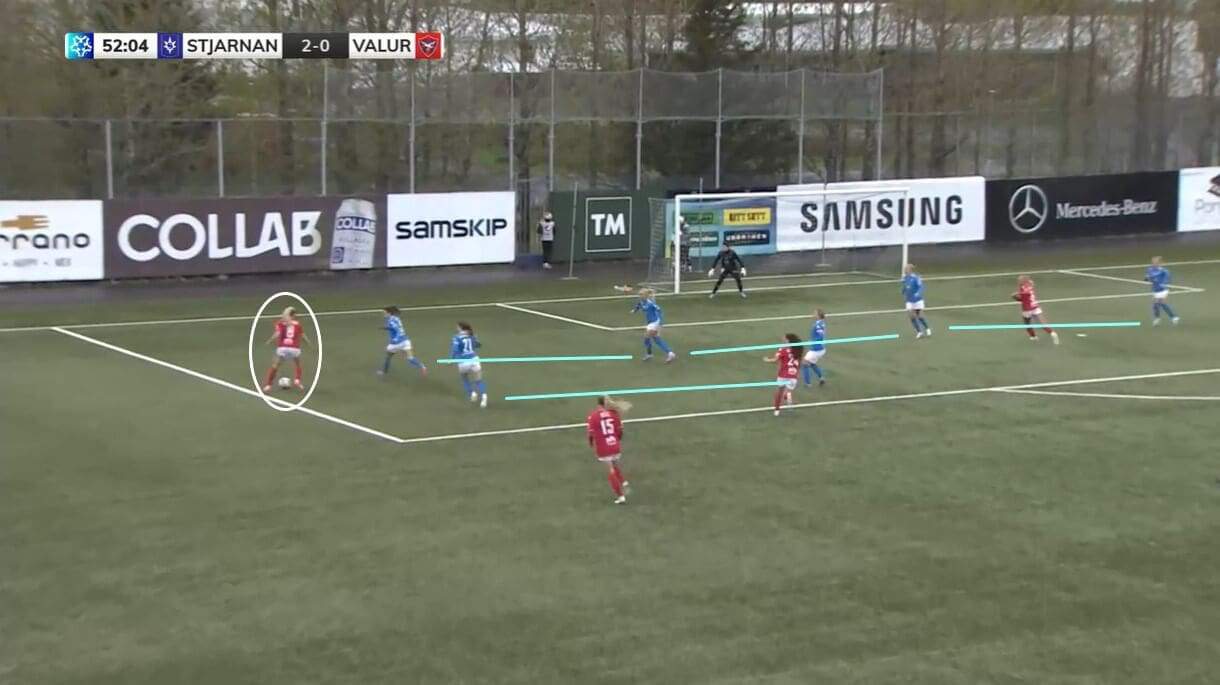
It is not only attacking where Stjarnan look stronger in numbers, as their defensive structure also looks more robust with players working together in the same area of the pitch. The game against Valur was a good example of that as they continually repelled offensive efforts through their compact shape and limited the possibilities for their opponents to create meaningful chances in the middle.
It is true that this was aided by Stjarnan taking a counterattacking approach to this match, meaning that they naturally stayed further back, but the fact that they managed to win this game 2-0 demonstrates how effective they can be when they do set up in an organised fashion. In this case, when Ásdís Karen Halldórsdóttir tried to find a teammate, the ball was easily intercepted by Jónsdóttir before being cleared by Hjartardóttir, and it was moments like this that showed what Stjarnan are capable of when they don’t make themselves as easy to play through.
Conclusion
In conclusion, this tactical analysis has looked at Stjarnan Women in greater detail, with a focus firstly on where they have been going wrong during the 2023 Besta deild kvenna season, and then looking at some of the reasons that their players and fans can have hope of getting themselves back on track as they strive for another top-two finish.
It should be mentioned that Stjarnan are not a team that many expect to lift the title season after season, with them only winning the league on four previous occasions (2011, 2013, 2014 and 2016), even though head coach Gudmundsson has stated publicly that that is their aim. However, there is an expectation that they will be Champions League contenders each year, and, even though it is never an easy goal to achieve, 2023 has been a particularly damaging season for them.
There are still eight games left to play, so there is time yet for them to achieve their aims, and they do have a Champions League campaign to look forward to in a few months’ time. However, if they want the chance to rub shoulders with the likes of Juventus Femminile, Arsenal Women and Celtic Women (who could all be drawn against them in the 2023/24 qualifying rounds) this time next year, then there is clear work to do between now and the end of the season.





Comments